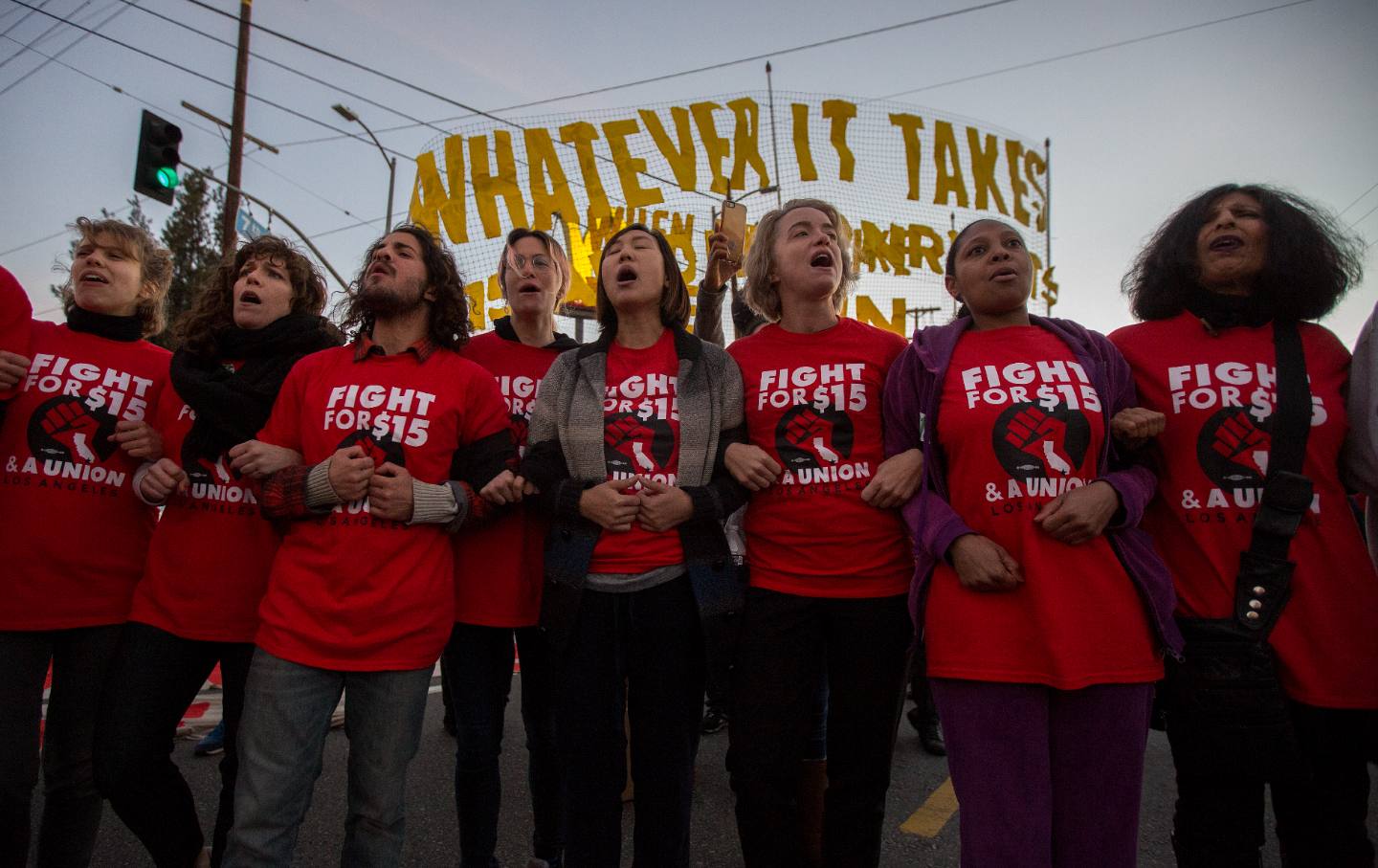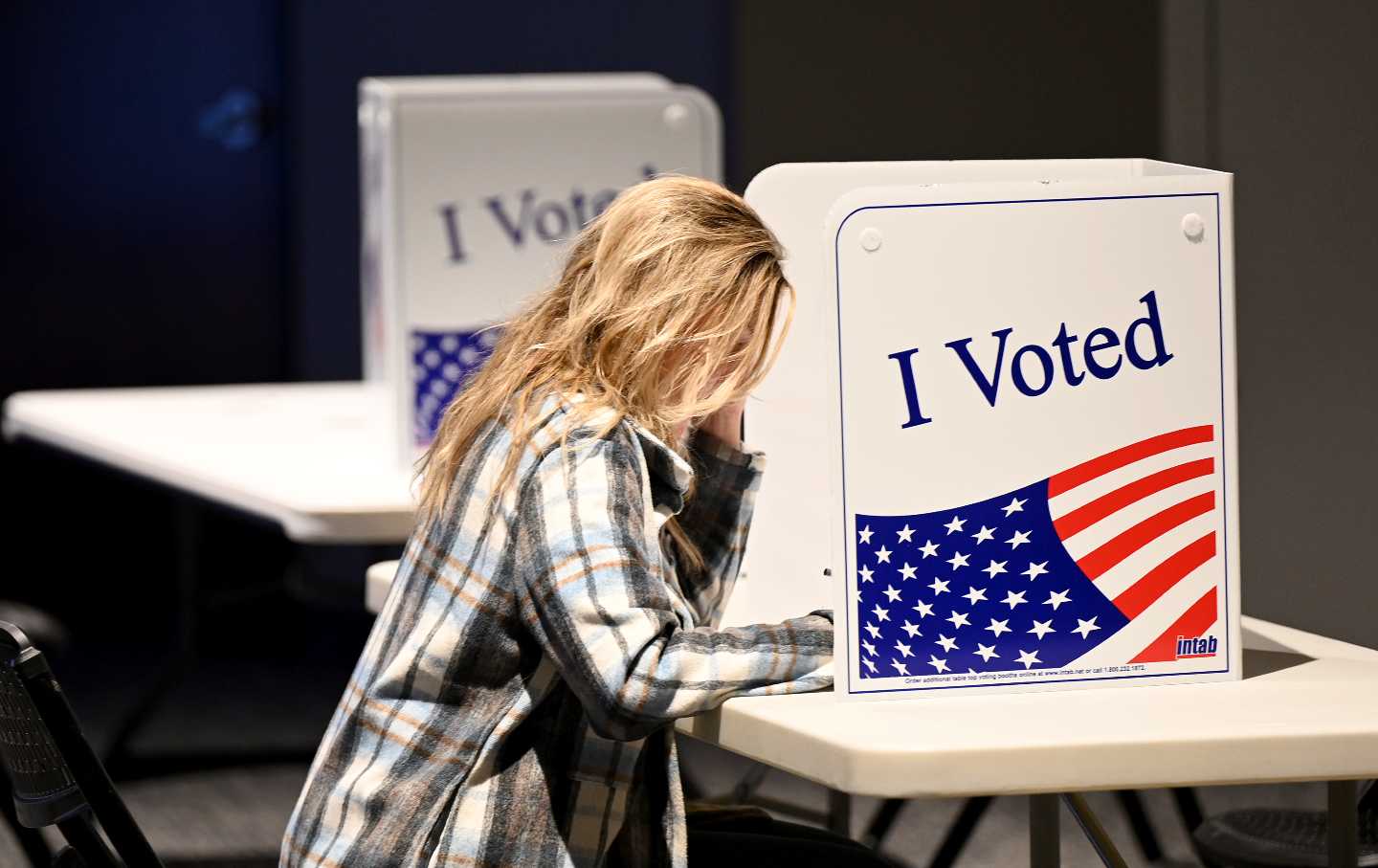Free School Lunches Kept Millions of Kids Fed During the Pandemic. Why Stop Now?
In North Carolina, the ending of the Covid-era federal meals program devastated low-income communities–and legislators have been slow to face the crisis.

A student looking at the options for their school lunch.
(SolStock / Getty)From her small apartment in Durham, N.C., Marcella Thompson prepares healthy meals and groceries for the dozens of families that struggle to put food on the table in her neighborhood.
“They can’t afford to buy it for their families, [so] farmers give us organic produce,” said Thomspon. “They have fruit, they have blueberries, they have strawberries, they [have] melons and greens and potatoes and so parents are able to give their kids nutritious meals.”
The Mustard Seed Project receives donations of locally grown fruit and vegetables, which they distribute in grocery bags to families. Recently, Thompson has also started to bring in treats to local neighborhoods, with food trucks and live music. “[We’re] able to take an ice cream truck, take a band, have nutrition meals, and play the music, go out into the complex and the children will come out, get their meals, go back in their [houses] and we move onto the next complex.”
Many of the low-income families Thompson serves relied on free lunch programs through the pandemic. North Carolina, along with the rest of the country, ended its pandemic era federally-funded free school meals program in September 2022, which provided over 1.4 million students in the state with free breakfasts and lunches. All other states also saw the federal support for their school meal programs disappear.
One school year later, communities in North Carolina have already experienced the catastrophic consequences of the program’s end. The state has historically struggled with food insecurity, even before the pandemic; 13.5 percent of children struggled with hunger in 2019, placing it as the 10th-hungriest state. “It had a really devastating impact on children—and not just poor children, but even middle class children.” Although qualifying students can still access free or reduced-price meals after the end of the program, various factors, including food stigma and rigid income-cutoffs, exclude students who are in need of the meals the most.
Andrew Harrell, a communications specialist at the Carolina Hunger Initiative and nonprofit No Kid Hungry, said that school meal programs are vital to students’ academic performance and focus in the classroom. “School meals don’t just fight food insecurity but are a big part of academic excellence for a lot of kids. They help kids feel socially and emotionally secure in the classroom.” Free school meals also take a burden off of struggling families, like the ones Thompson serves through the Mustard Seed Project. “Not all families know [where] their next meal is going to come from,” said Harrell. “Having access to school meals for free at no cost to families was a huge, huge benefit during the pandemic and the ability to access those meals at no cost to families.”
Current qualifications for free school lunch rely on a system of strict income cutoffs, so students who fall just over the required guidelines are passed over for services that they need. In 2019, a four-person household would need an annual income of $33,475, or less, to qualify for free school lunch. Even though the cutoff rose to $39,000 for the upcoming school year to include more families, it ignores those that make just above that value; a family of four making $39,100 wouldn’t qualify.
This leaves a demographic of families who are unable to access the necessary support they need to feed their families, and places strain on food banks and other local organizations in providing for families. Oftentimes, these organizations don’t receive the funding they need to serve at the level that is needed. “It’s kind of been an unfortunate timing where these programs have ended, [and] this [forced] a lot of families to bring higher demand on food banks and food pantries,” said Harrell.
Thompson’s work introduces another key aspect that free school meals were able to provide: nutrition. “A lot of people don’t appreciate how healthy school meals are. Tufts University did a 15-year study that was recently completed and found out that school meals are the healthiest source of food for many Americans,” said Harrell. The investigation found that the percentage of unhealthy school meals programs decreased from 55.6 percent to 24.4 percent; significant disparities in diet quality relating to education and income levels were also reported.
At home, a majority of the kids Thompson serves eat highly processed, cheap, and easy-to-make food. These dietary habits can adversely impact children’s health later in life, and lead to increased risk of obesity and certain cancers.
Even though schools host summer meals programs across the state for summer break, the students that need them most are often unable to access them. “There are a few programs that are delivering lunch to children, but they’re in specific areas,” said Thompson. “There is no access.”
In the legislature, several North Carolina lawmakers are fighting to change recent policies, including Representative Julie von Haefen. “We’re still in the middle of our state budget negotiations,” said Haefen. “There’s still a lot of advocacy around this issue from a lot of the coalition partners. School Meals for All North Carolina which is a big group that’s been down here almost every week this session, advocating for this funding to be [put] into the state budget.”
The lack of attention from legislators towards food insecurity and school nutrition is frustrating, said Haefen. “We’ve been focusing on all the wrong issues this year.” Alongside Representative Cynthia Ball, Haefen introduced House Bill 844, titled the “School Meals for All Act,” which would reestablish the free school meals program. The bill gives public schools the power to establish “school nutrition services in the schools, under their jurisdiction.”
Popular
“swipe left below to view more authors”Swipe →“Data shows that offering no cost school meals to students reduces hunger, it improves academic performance. And if we really want to be focused on improving the lives of kids in our state, these are the types of those we should be focused on,” Haefen said.
The North Carolina legislature, however, lacks similar enthusiasm. Haefen remains hesitant as to whether the bill will garner enough support to pass, despite advocates’ efforts.
It’s not a funding issue. House Bill 844 would cost just $172 million to implement, according to the filed bill—a tiny fraction of the state’s $27.9 billion budget for 2022. It’s also not because of a lack of evidence that universal school meal programs are effective. Vermont and Minnesota, two states that signed universal free lunch bills into law this past school year, are among the most food secure states in the county, with 8.9 percent and 6.8 percent of residents struggling with hunger, respectively.
But mitigating food insecurity requires more effort than the passage of a single bill. According to Harrell, building resilient food systems requires support from every level of the community, from politicians to parents. “It seems like every year there are some independently written bills that try and address funding more meals for kids. And we’re always excited to see those come out. But we are really focused on finding ways to work at the local and state and the national level for the long term with partners statewide to try and make [this] happen.”
Several bills under the 2023 Farm Bill encompass the long-lasting, sustainable change that Harrell emphasizes. Among them, national bills Improving Access to Nutrition Act and Closing the Meal Gap Act were both introduced to Congress in 2023.
“I have a real difficult time when we have our legislators that are supposed to represent all of us, not certain people,” said Thompson, mentioning the importance for lawmakers to represent this issue in the legislative chambers. “There’s a problem there. And there’s a real disconnect with the people that they’re supposed to be serving.”
Thompson hopes to visit Washington, D.C., in the coming months to speak out on a national level. “Every child, in every state had free lunch no matter what the condition was,” she said. “And if you’re getting through in Covid, why can’t you continue that program?”
More from The Nation

Democrats Are Overdue for New Leadership Democrats Are Overdue for New Leadership
To mount an opposition under the coming Trump administration, the party needs new ideas—not the same establishment clinging to power.

Why Democrats Are Losing Americans Without a College Degree—and How to Win Them Back Why Democrats Are Losing Americans Without a College Degree—and How to Win Them Back
Voters intuitively understand that the economy has not worked well for most of us for decades. Democrats must offer them a big transformative vision, and stick to it for as long a...

Enough With the Bad Election Takes! Enough With the Bad Election Takes!
To properly diagnose what went wrong, we need to look at the actual number of votes cast.

No, Kamala Harris Staffers Did Not Run a “Flawless” Campaign No, Kamala Harris Staffers Did Not Run a “Flawless” Campaign
Democratic strategists are still patting themselves on the back for a catastrophic defeat.




